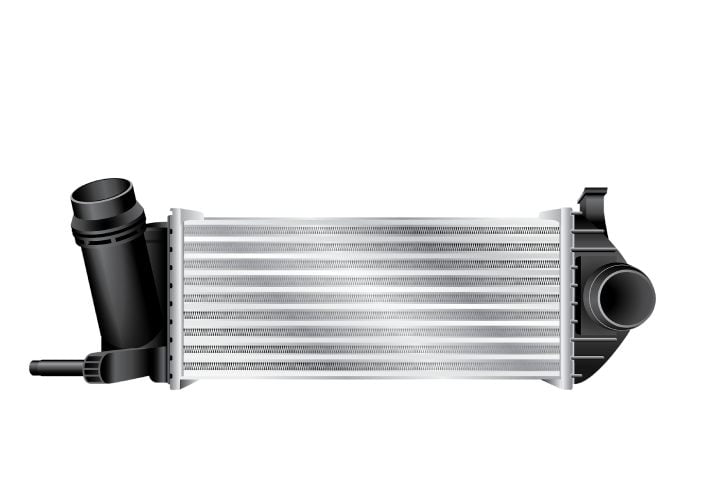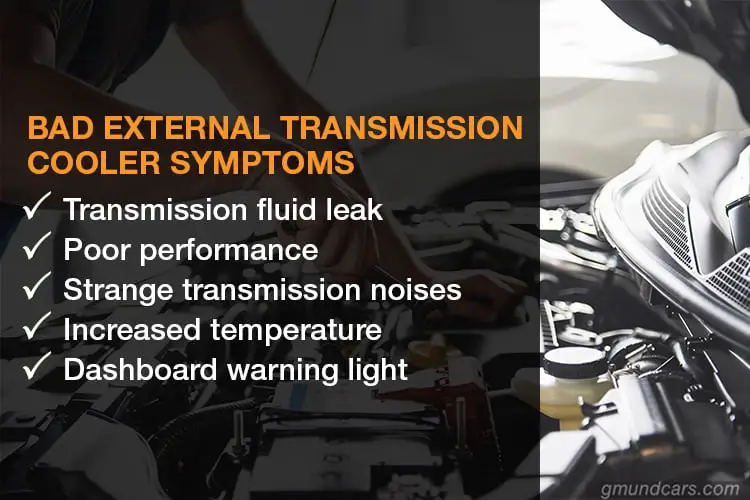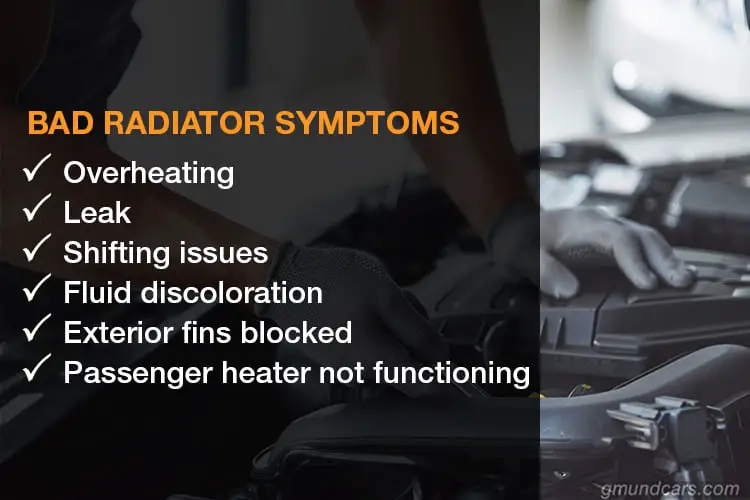It may be confusing when you hear people talk about installing an external transmission cooler or replacing the existing one. The truth is the cooler can improve the performance of your car and extend the transmission’s lifespan. But do you need it if you have a radiator?
They are different units designed for specific use. Continue reading to find out more.
External Transmission Cooler And Radiator Similarity


- An external transmission cooler and radiator do the same work: cooling fluids.
- They are both external devices.
- The two use the same heat exchanger principle to extract heat from coolant or transmission fluid.
Read more: Transmission leak: Symptoms, causes and repair guide
External Transmission Cooler and Radiator Difference
The key difference is that the external transmission cooler cools transmission fluid, while the radiator cools coolant from the engine. They are both external devices but with different structures. Their location on the car is also different. In vehicles with integrated transmission systems, a radiator also has compartments for cooling transmission fluid.
For a better understanding of the difference between an external transmission cooler and a radiator, have a look at the chart below:
| External Transmission Cooler | Radiator | |
|---|---|---|
| Definition | An external cooler is an additional device used to lower transmission temperature. | A radiator is part of an engine’s cooling system that helps to remove excess heat from water or coolant that circulates through it. |
| Function | Keeps the transmission temperature low by cooling the transmission fluid. | Keeps the engine temperature at the recommended value by cooling the engine water or coolant. |
| Location | Fitted in front of the radiator or air conditioning condenser. | A radiator is located under the hood. It is usually the large panel at the front of the car. |
| Structure | The structure of external transmission coolers depends on the type, but they use the same principle. They are mounted on the vehicle and allow transmission fluid to pass through them, cooling in the process. They can have tube and fin, plate and fin, or stacked plate as a cooling mechanism. | A radiator consists of the pressure cap, outlet and inlet tanks, and the core. The core has rows of narrow metal fins for dissipating heat from the hot antifreeze water or coolant from the engine block. |
| Types | • tube-and-fin cooler • plate-and-fin cooler • stacked-plate cooler | • Tubular type radiators • Cellular type radiators |
Read more: Transmission flush: Never do it before reading this guide
External Transmission Cooler Operating Principle, Bad Symptoms, And Replacement Cost
An external transmission cooler is a heat exchanger that helps extract heat from the transmission fluid as the fluid circulates through it. But how does it achieve that function? Keep scrolling to learn more from its operating principle.
External Transmission Cooler Operating Principle
A transmission cooler uses the same principle as heat exchangers. It is usually mounted near the radiator or air conditioning condenser for maximum airflow. The hot transmission fluid flows through a series of fins, tubes, or plates. The heat from the transmission fluid dissipates away with the help of an air current that flows over the unit. The transmission fluid now at a lower temperature flows back to the transmission system, and the cycle starts again.
Bad External Transmission Cooler Symptoms

An external transmission cooler helps extend the lifespan of a transmission system by keeping its temperature in check. If it is faulty, it will fail to extract heat from the transmission fluid. That can be catastrophic, especially if you tow heavy loads or drive across rough terrain. You should know when the cooler is faulty by observing any symptoms. A bad external cooler will show the following signs:
Transmission fluid leak:
It is easy to know when the transmission fluid leaks from the external transmission cooler by its bright red color. Inspecting your vehicle every morning before you drive off will help you identify the problem on time. The leakage occurs from the lines in the cooler if they crack or corrode. This problem is common in humid areas of coastal regions. Fortunately, it can be quickly fixed by replacing the line.
Poor performance:
An external transmission cooler failure can lead to a significant fluid loss. When the level falls below the recommended minimum, you will start experiencing troubles with the transmission. It may lag or fail to shift gears. This problem also triggers warning lights on the dashboard, which you should look out for. If you notice performance reduction, contact your mechanic.
Strange transmission noises:
Problems with the transmission system due to fluid leakage are often associated with strange noises. They result from gears and other transmission parts grinding against each other. Apart from cooling, transmission fluid reduces friction between the moving surfaces. Report to your auto mechanic the moment you hear any strange noise from the transmission. Do not drive your car with such signs to avoid further costly damages to your transmission system.
Increased temperature:
The external transmission cooler does the one purpose of cooling transmission. If you get a high transmission temperature warning on your dashboard or instrument panel, the device is faulty. Low transmission fluid will lead to temperature rise. Also, if the cooler is blocked or does not radiate enough heat from the transmission fluid, the fluid temperature will increase. Take the vehicle to an authorized dealer for diagnosis and fixing.
Dashboard warning light:
Modern vehicles have many electronic components and systems that monitor your car. A temperature sensor attached to the transmission system alerts the Electronic Control Unit (ECU) if it detects temperatures higher than the recommended maximum. ECU then triggers a dashboard warning light to alert you of the problem. The high-temperature warning light requires immediate attention to save your transmission system.
Read more: Radiator flush: The last guide you’ll ever need [with top 6 items review 2021]
External Transmission Cooler Replacement Cost
The cost of replacing an external transmission cooler varies depending on the vehicle model. Typically, it costs about $100-$300. The component should cost around $200 and an additional $100 for labor. If you are simply replacing a faulty transmission cooler, you can do that in your garage. Just remove the old one and fix the aftermarket to save on labor costs.
However, you will require the help of an expert if you want to install a new external transmission cooler for performance improvement. The professional mechanic understands the device and system better. He can run lines as appropriate and amount the unit at the best location for maximum cooling.
Radiator Operating Principle, Bad Symptoms, And Replacement Cost
The heat produced in the engine block is enormous. If left undissipated, it can damage the engine in just a short time. Cooling is done by the engine’s cooling system, with the radiator as the central component. It works as a heat changer to extract heat from the antifreeze water or coolant, cooling it in the process. The unit consists of various components that aid its operation. A radiator keeps your engine alive by preventing overheating.
Radiator Operating Principle
The engine’s cooling system consists of a liquid coolant, hoses, a fan, a thermostat, and a radiator. The hot coolant is pumped from the engine block through the inlet hose into the inlet tank. The hot coolant circulates in a metal plate with metal cooling fins. This is the functional unit of a radiator. Heat in the coolant dissipates into the cool air that flows over the metal fins.
The radiator has a pressure cap that secures the cooling system. It allows the hot coolant to stay pressurized without spilling over up to a certain point when the pressure is released. Once the coolant has been cooled down to the appropriate temperature, it goes to the outlet tank. The coolant at lower temperature gets back to the engine block through the outlet hose, where the cycle begins again.
Read more: How to choose the best radiator stop leaks 2021
Bad Radiator Symptoms
A faulty radiator will trigger different signs and symptoms. As a driver, you should be aware and take the necessary steps to save your engine. We may not highlight all symptoms, but the following are the most common ones:

Overheating:
The purpose of a radiator is to cool the coolant, which, in turn, cools the engine. An engine’s cooling system has a sensor that monitors the coolant temperature. If it goes above the limit, a warning light comes on. Your radiator may be the culprit. The problem can be caused by a defective thermostat that controls its operation.
Leak:
A leaking radiator will lead to a low coolant level. The remaining amount becomes ineffective to cool the engine. The color varies depending on the type of coolant that you use. Apart from physical inspection to confirm the leakage, you can also examine the time you topped up the fluid and when it needs refilling. If the duration is shorter than usual, there is a possibility of leakage. Check for any cracks on the radiator and replace it if necessary.
Shifting issues:
This symptom only occurs in vehicles with integrated transmission systems. If there is a crack, the coolant can mix with the transmission fluid. The contaminated fluid does not perform as expected, leading to transmission failures, such as trouble shifting gears. Take your vehicle to an auto repair shop for further diagnosis.
Fluid discoloration:
Most coolants are yellow, green, red, or pink. This fluid circulates through the engine block, radiator, and back to the engine. If the radiator is damaged, you can find debris or sludge deposited on the coolant. That can lead to discoloration. To check if that has occurred, examine the coolant color in the overflow tank. Contaminated coolant is more resistant to flow and may block the passages within the radiator.
Exterior fins blocked:
The radiator needs an unobstructed airflow to effectively cool the coolant. Blocked or clogged fins reduce the cooling efficiency of the radiator. You can check the radiator fins if the high engine temperature warning light appears on your dashboard. Clear it off using a high-pressure garden hose to clear the air passages through the fins. The fins may also be bents or damaged as in the case of an accident. Just inspect them to ensure it is not the case.
Passenger heater not functioning:
If you turn on the AC and do not get the heat as expected, your radiator may be the problem. Your AC system relies on the heat extracted from the coolant to heat your car.
Read more: Coolant vs. Water: Which is cool for your radiator?
Radiator Replacement Cost
Radiator replacement cost varies depending on the type, size, placement, and vehicle model. It ranges from $292 to $1193 for both component and labor. On average, people pay about $671 for replacement. Due to the complexity of the process, some auto repair shops charge $100 per hour for labor. It is not a DIY procedure. So, you are better off taking your vehicle to a professional mechanic.
FAQs
1. Can we use a radiator as an external transmission cooler?
No. Though they function the same, you cannot swap an external transmission cooler with a radiator. There will be a mounting problem given the massive size of radiators. Also, radiators are designed for extracting heat from the coolant and not transmission fluid. Some radiators have built-in transmission fluid coolers, but you can use them as external coolers. They are only for use in vehicles with integrated transmission systems.
2. Is an external transmission cooler better than a radiator?
The external cooler not only gives you a much greater surface area to extract heat from but also doesn’t alter the cooling abilities of the radiator. So, it is a better choice.
3. Should the transmission cooler be before or after the radiator?
We recommend installing the auxiliary cooler after the radiator to return the cool fluid directly to the transmission. Installing the cooler before the radiator will still provide additional cooling and may be necessary for some difficult-to-access applications.
4. Is it safe to bypass the radiator transmission cooler?
No. Bypassing your radiator transmission cooler can lead to transmission overheating. This shortens the transmission fluid lifespan and causes premature transmission system failure.
Conclusion
An external transmission cooler and a radiator cool the transmission and engine, respectively. The two use the same heat exchanger principle to extract heat from coolant or transmission fluid. Keeping these devices functioning will extend the life of your transmission and engine. Constantly monitor them for any fault symptoms and take the best action to save your car.